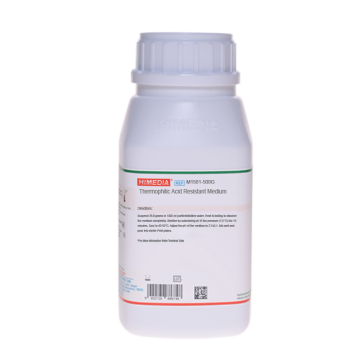 Your enquiry has been submitted
Your enquiry has been submitted
Thermoacidurans Broth
Intended Use
Recommended for detection of thermophilic/ mesophilic aerobic and anaerobic aciduric spore formers and sterility testing of acid food.
Composition**
| Ingredients | Gms / Litre |
|---|---|
| Proteose peptone | 5.000 |
| Yeast extract | 5.000 |
| Dextrose (Glucose) | 5.000 |
| Dipotassium hydrogen phosphate | 4.000 |
Final pH (at 25°C): 5.0±0.2
**Formula adjusted, standardized to suit performance parameters
Directions
Suspend 19 grams in 1000 ml purified / distilled water. Heat if necessary to dissolve the medium completely. Sterilize by autoclaving at 15 lbs pressure (121°C) for 15 minutes. Cool to 45-50°C. Mix well and dispense into tubes or flasks as desired.
Principle And Interpretation
B. coagulans is a soil microorganism that can also be found in canned tomato products and dairy products. Conditions favorable to multiplication of the organism can result in spoilage of the food product (5). B. coagulans is also referred to as B. thermoacidurans (2). B. coagulans is described as a facultative thermophile, that can grow at 20°C to 55°C and can also grow at pH levels between 5.0 to 7.0.
Proteose peptone and yeast extract provide nitrogenous, carbonaceous compounds, vitamin B complex and other essential growth nutrients. Dipotassium phosphate buffers the medium. Dextrose acts as an energy source.
Type of specimen
Food and dairy samples; Soil samples
Specimen Collection and Handling
For food and dairy samples, follow appropriate techniques for sample collection and processing as per guidelines (1,5,7). For soil samples, follow appropriate techniques for sample collection, processing as per guidelines and local standards (6). After use, contaminated materials must be sterilized by autoclaving before discarding.
Warning and Precautions
Read the label before opening the container. Wear protective gloves/protective clothing/eye protection/ face protection. Follow good microbiological lab practices while handling specimens and culture. Standard precautions as per established guidelines should be followed while handling specimens. Safety guidelines may be referred in individual safety data sheets.
Limitations
- Some strains may show poor growth due to nutritional variations.
- Further biochemical and serological test must be carried out for complete identification.
Performance and Evaluation
Performance of the medium is expected when used as per the direction on the label within the expiry period when stored at recommended temperature.
Quality Control
Appearance: Cream to yellow homogeneous free flowing powder
Colour and Clarity of prepared medium: Yellow coloured clear to slightly opalescent solution
Reaction: Reaction of 1.9% w/v aqueous solution at 25°C. pH : 5.0±0.2
pH: 4.80-5.20
Cultural Response: Cultural characteristics observed after an incubation at 55°C for 18-48 hours.
| Organism | Inoculum (CFU) | Growth |
|---|---|---|
| Bacillus thermoacidurans ATCC 8038 | 50-100 | luxuriant |
Storage and Shelf Life
Store between 10-30°C in a tightly closed container and the prepared medium at 15-25°C. Use before expiry date on the label. On opening, product should be properly stored dry, after tightly capping the bottle in order to prevent lump formation due to the hygroscopic nature of the product. Improper storage of the product may lead to lump formation. Store in dry ventilated area protected from extremes of temperature and sources of ignition. Seal the container tightly after use. Product performance is best if used within stated expiry period.
Disposal
User must ensure safe disposal by autoclaving and/or incineration of used or unusable preparations of this product. Follow established laboratory procedures in disposing of infectious materials and material that comes into contact with clinical sample must be decontaminated and disposed of in accordance with current laboratory techniques (3,4).
Reference
- American Public Health Association, Standard Methods for the Examination of Dairy Products, 1978, 14th Ed., Washington D.C.
- Becker M. E., Pederson C. S., 1950, J. Bacteriol., 459:717
- Isenberg, H.D. Clinical Microbiology Procedures Handbook. 2nd Edition.
- Jorgensen, J.H., Pfaller , M.A., Carroll, K.C., Funke, G., Landry, M.L., Richter, S.S and Warnock., D.W. (2015) Manual of Clinical Microbiology, 11th Edition. Vol. 1.
- Salfinger Y., and Tortorello M.L. Fifth (Ed.), 2015, Compendium of Methods for the Microbiological Examination of Foods, 5th Ed., American Public Health Association, Washington, D.C.
- Subba Rao N. S., 1977, Soil Microorganisms and Plant Growth, Oxford and IBH Publishing Co., New Delhi.
- Wehr H. M. and Frank J. H., 2004, Standard Methods for the Microbiological Examination of Dairy Products, 17th Ed., APHA Inc., Washington, D.C.
| Product Name | Thermoacidurans Broth |
|---|---|
| SKU | M1911 |
| Product Type | Regular |
| Physical Form | Powder |
| Origin | Animal |
| Packaging type | HDPE |
| References | 1. Downes and Ito (ed.). 2001. Compendium of methods for the microbiological examination of foods,4th ed. American PublicHealth Association, Washington, D.C |
| Customized Product Available | No |





